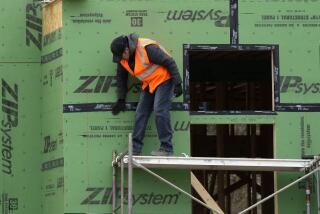Durable Goods Orders Up 4.3%
- Share via
WASHINGTON — Orders to U.S. factories for “big ticket” durable goods jumped 4.3% in July for the biggest one-month gain since 1984, the government said Friday.
However, analysts suggested that the news wasn’t as promising for the sluggish national economy as it might have seemed at first glance.
Michael Evans, president of Evans Economics in Washington, said details in the report disappointed him after his first reaction of “Oh boy!” when he saw the total increase for durable goods, which are those items expected to last three years or more.
And Gordon Richards, director of economic analysis for the National Assn. of Manufacturers, said bluntly, “These figures look better than they actually are.”
However, Douglas Handler, an economist with the Philadelphia forecasting firm Wharton Econometrics, said, “In these figures, perhaps we might be seeing signs of the good times ahead that economists have been forecasting for six or eight months.”
White House spokesman Larry Speakes said he was heartened by the report.
“This welcome news bodes well for shipments in the second half of the year, reinforcing our belief that the economy will be further strengthened in the coming months,” Speakes said in a statement issued in Santa Barbara, where President Reagan is vacationing.
Much of the report, compiled by the Commerce Department, did look good. It said:
- Overall orders climbed to $107.2 billion in July. The 4.3% gain over June, the biggest since 8.2% in November, 1984, came on the heels of a tiny 0.1% increase in June and declines in the previous three months.
- Military orders, a historically volatile category, soared 46.6% in July, accounting for much of the general gain.
- Non-military orders were up 1.1%, about the same as their 1.4% rise in June.
- Orders for non-defense capital goods, which are closely watched for signals of industry plans to expand production, rose 3.8% after increasing 1.1% in June.
The problem, according to analysts Evans and Richards, was that the gains were concentrated in military hardware and in a 22.9% increase for transportation equipment, both military and civilian. Excluding transportation, in fact, durables orders for the month would have been down 1.2%.
The government doesn’t break down the figures into great detail, but Evans said he suspected that much of the transportation increase was in civilian aircraft orders from overseas--a big help to a few U.S. companies but not a broad boost for manufacturing.
Richards said: “The increase in transportation orders is not a sign of economic revival.
“Rather, in view of the fact that tax reform is likely to substantially reduce depreciation deductions, businessmen are front-loading orders for transportation equipment in order to be able to take advantage of accelerated depreciation writeoffs while they are still available,” he said.
More to Read
Inside the business of entertainment
The Wide Shot brings you news, analysis and insights on everything from streaming wars to production — and what it all means for the future.
You may occasionally receive promotional content from the Los Angeles Times.









